Jade, considered as the material used for prehistoric tools and objects of art, has numerous aspects of interest. The special properties of nephrite and jadeite responsible for their characteristic appearance and hardness can be used to distinguish between them, and to differentiate them from other minerals. The occurrences of jade in relatively few localities throughout the world, and the connection between these localities and the areas where jade has been worked, raise interesting questions. Finally, investigation of the history of the working of jade produces evidence of a great deal of skill involved, even at very early periods.
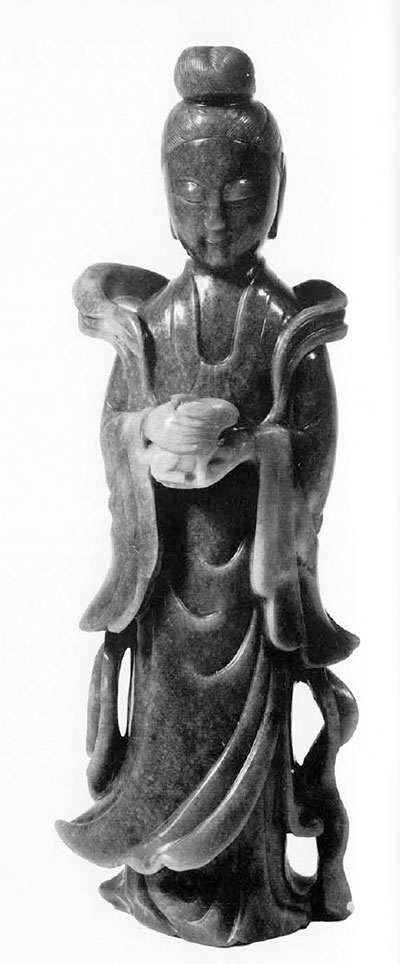
The names of the jade minerals have a complex history. There was no reference to jade in the mineralogical or pharmacological literature of the West before the discovery of America. Then the Spaniards found a green stone, called chalchiutl by the Aztecs, being used for decorative carving among the natives of Mesoamerica. They attributed curative properties, especially for the kidneys, to this stone, and named it piedra de yiada, stone of the loins. from the French pierre l’ejade came le jade, and thence the name jade. By the middle of the seventeenth century, when Oriental stone carvings began to reach Europe, the name jade was transferred to them, since Mesoamerican jade was by then extremely rare and nearly forgotten. The mineral name nephrite was first applied at the end of the eighteenth century, deriving from the Latin lapis nephriticus, another version of the original Spanish name. Finally, between 1846 and 1881 the French mineralogist Damour established that there are two distinct types of jade mineralogically, that from Turkestan for which he retained the name nephrite, and that from Central America and Burma, for which he coined the name jadeite. The Chinese used the word yu to describe jade in the very general sense, meaning hard stone carvings of any kind of stone, as well as nephrite and jadeite. The name fei-ts’ui, the Chinese word for kingfisher, was originally applied to fine green nephrite from Turkestan, and then revived in the nineteenth century to describe emerald green Burma jadeite.
The single property of jade which is common to both nephrite and jadeite, and perhaps the most well known, is its hardness. Jade provided almost indestructible tools for prehistoric peoples and a challenge to later lapidaries who worked it into decorative objects of various kinds, chiefly in China and Mesoamerica. However, jadeite and nephrite have little else in common. Even the green color generally thought to be so characteristic of jade has a different quality in each mineral, due to basic differences in structure and composition, and much jade of both kinds is not green.
The mineral nephrite is a calcium magnesium silicate and is a member of the amphibole group of minerals. It is a compact variety of the mineral series tremolite-actinolite, which is a species of this group. Pure tremolite, a calcium magnesium silicate, is white; actinolite, a calcium magnesium iron silicate, is green due to the presence of iron. In tremolite-actinolite the fibrous crystals are separate, while in nephrite they are tightly felted or matted together and the compact, tufted structure which results accounts for its extreme toughness. The hardness of nephrite is 6.5 on the Mohs hardness scale, on which talc is the softest at 1 and diamond the hardest at 10. The specific gravity of nephrite is 2.90-3.01. This represents the ratio of its density to that of water; thus nephrite is about three times heavier than water. The variety of colors ranges from white through yellow, green, brown and gray of many shades, to black. Rarely it is blue. Most of the colors are due to various iron compounds, although white nephrite with high iron content has occasionally been found, so that the means by which it is colored is not yet completely explained.
The mineral jadeite is a member of the pyroxene group of minerals, and is essentially a silicate of aluminum and sodium. The individual crystals of jadeite are interwoven in a complex way, and generally have a granular appearance but they are not fibrous and matted together as in nephrite, so that jadeite is not nearly so tough as nephrite; it is somewhat harder, having a hardness of 7 on the Mohr scale. It is denser than nephrite, with a specific gravity of 3.30-3.36, and this difference in the specific gravities of the two minerals has been used to differentiate them. The typical bright emerald green of jadeite is due to the presence of chromium; the cause of the mauve and bluish-gray colors sometimes found is not certainly known. There are two additional varieties of jadeite. Diopside-jadeite is a species intermediate between jadeite and diopside, a calcium magnesium silicate; it is found almost exclusively in Mesoamerica. The other variety is a chloromelanite, a species intermediate between jadeite and acmite, another sodium aluminum silicate, or between jadeite, acmite, and diopside. Chloromelantine is typically very dark green or black, owing to its high iron content.
The identification of objects of jade is possible in various ways. Much information can be obtained if the hardness of the stone in question is known. An ordinary penknife will not scratch jadeite or nephrite, and this is usually a fairly good confirmation of jade if the limitations of the test are realized. It does not distinguish between nephrite and jadeite, and it should be borne in mind that minerals do exist which are as hard as jade and might be mistaken for it; for example there is an unusually hard, pale green variety of serpentine called bowenite which has a hardness of 6 and an appearance very like jade. Surface alteration, of Chinese tomb jades in particular, can cause the surface of the jade to be soft, so that the area for testing must be chosen carefully. Specific gravity determinations have been used as a means of identification of jade but when the surface is altered, or when there are cracks or holes, however minute, in the object, the results cannot be depended upon. Chemical analysis can give useful information, but requires a gram or so of material which is usually more than can be easily obtained. For complete mineralogical research where the exact chemical composition is desired, and sufficient sample is easily available, it is of course indispensable.

A limited amount of spectrographic analysis of ancient jade has been done; this requires only ten to twenty milligrams of material, which is not difficult to obtain in most cases, and this method might merit more extensive use. Optical methods give the most rapid and definite results. The determination of the mean refractive index, bu observing a few grains of the mineral immersed in a drop of appropriate liquid on a microscopic slide under a petrographic microscope, can be done rapidly, and can be used to differentiate between the different varieties of jadeite, between jadeite and nephrite, and between jade and many of the jade-like minerals. Perhaps the most definitive optical method is the x-ray diffraction powder method.; this is particularly applicable to valuable objects because only a few milligrams of powder scraped from the object are required. A narrow beam of x-rays is allowed to pass through the powdered mineral which diffracts them into a pattern of lines. This is recorded on photographic film which can then be compared with films having patterns of known nephrite or jadeite, or any other mineral. Identification of the unknown depends on the fact that each crystalline material yields a characteristic pattern.
Jade which has suffered some surface alteration has already been mentioned. It is characteristic only, to my knowledge, of Chinese tomb jade and has resulted from changes which have taken place during burial. Numerous references have been made in books and exhibition catalogues to ‘jade patina’ and ‘calcified’ or ‘calcined’ jade. The opaque or cloudy areas referred to usually retain the shape and design of the object although when decomposition has progressed further some of the surface may be lost. Evidently water leaches chemicals from the soil and the resulting solutions attack the surface of the jade. Decomposition products of bodies in the tombs would undoubtedly accelerate this attack. It has been noted that this surface alteration, as determined by x-ray diffraction, is not a different mineral but merely a softened form of nephrite. This observation has been confirmed by the x-ray diffraction examination of several tomb jades in the Freer Gallery of Art which show this altered surface.
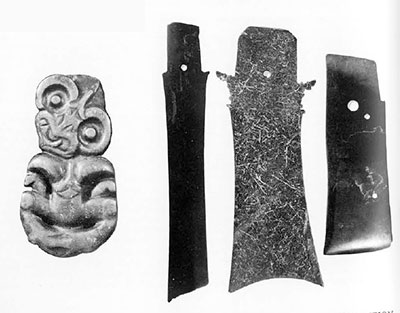
The jade with a curious ivory-like appearance which the Chinese call ‘chicken-bone’ jade may be a manifestation of this phenomenon. This is also sometimes said to be ‘burnt jade.’ Burnt jade also has an opaque chalky appearance, usually with minute cracks all over the surface. It is known that nephrite when heated to about 1000 degrees Celsius in a dry atmosphere breaks down into diopside, eustatite ( a magnesium silicate) and some quartz. In an experiment in the Freer Gallery Laboratory, samples of blue-green and white nephrite were submitted to temperatures up to 1025 degrees Celsius and both altered to an opaque chalky beige color with no change in the shape of the piece or the decoration of the surface. The chief mineral which resulted was diopside, and several nephrite jades in the Freer which appear to have been burnt also give a diopside x-ray diffraction pattern. Jadeite when heated in a similar manner behaves quite differently; it fuses to a glassy material, the surface smooths out, and if the object is small enough it bends out of shape. Jadeite beads from Mesoamerica have been described which not only are warped out of shape, evidently due to heat, but are dull and crumbly on the surface, perhaps due to exceedingly high temperatures.
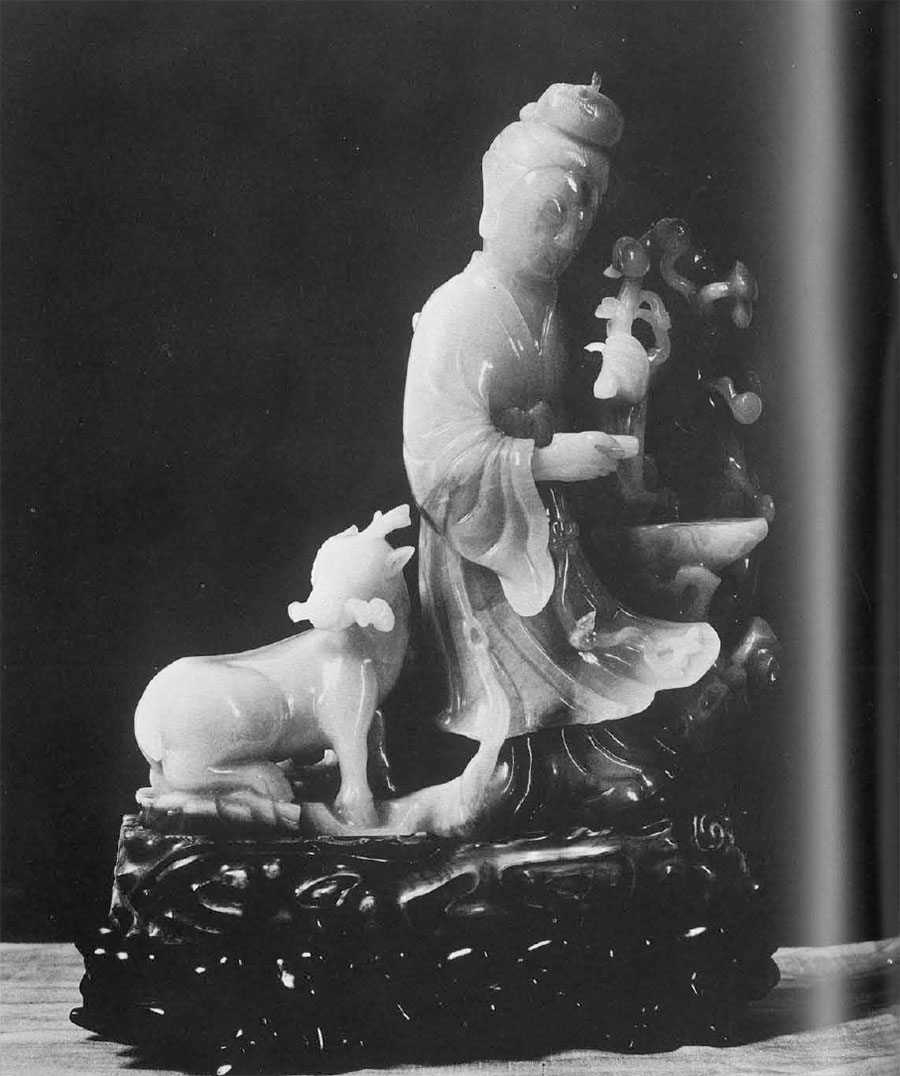
Although China has been a center of jade carving for centuries, no jade occurs in China proper. The old idea that the jade first used by the Chinese came from somewhere in China, and that when this ran out it began to be imported from Turkestan, has been shown to be untrue by S. Howard Hansford in his study of Chinese jade carving. For at least two thousand years the nephrite carved in China was imported from eastern Turkestan, the Chinese province of Sinkiang. Nephrite is found in the river valleys on the south side of the K’un-lun mountain range, which runs between Tibet and Turkestan. Two of these rivers, the Karakash (black stone) and Yurungkash (white stone) join a short distance north of the city of Khotan. The earliest mention of the jade trade into Khotan was by Marco Polo in 1272, and a Manchu author writing in 1777 mentions the jade mines in these valleys. The jade workings along the Karakash were described in detail by H. Cayley, an English traveller, who saw them in 1870, and by Ferdinand Stoliczka, a naturalist attached to the Geological Survey of India, who was there three years later. Pits and holes had been dug in the slope and fragments of jade were heaped outside the entrances. The color of the nephrite is described as white, various shades of green of which the pale green was the most common, and occasionally nearly black. Fires were built next to the jade to crack it, after which it could be more easily broken away. In addition to that obtained from the mines, jade was also found in the form of pebbles and boulders, often with a brown weathered rind, either in the rivers themselves which had brought them down from the deposits higher in the mountains, or in the dried-up river beds and alluvial deposits along the rivers. Other nephrite deposits are known in the area farther to the west around Kashgar and Yarkand, notably around the Belurtag or ‘Jade Mountain’ about eighty miles from Yarkand.
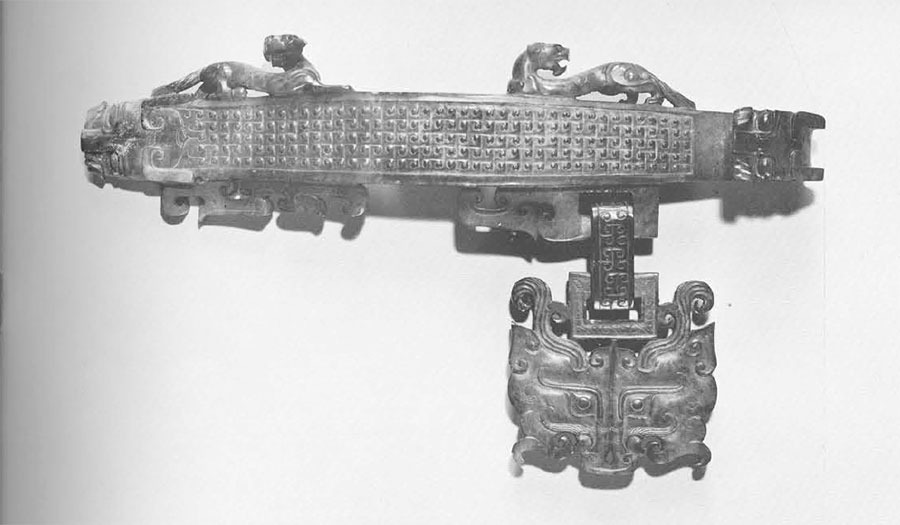
Another source of nephrite in Central Asia is in Siberia. This was never used by the ancient Chinese, although in this century Siberian nephrite reaches the Chinese market. Water-worn boulders, some weighing up to two tons, had been observed in the rivers south of Lake Baikal early in the nineteenth century, and in 1850 a French engineer found nephrite in this area in situ along the Onot River in the Botogol mountains south of Irkutsk. Typical Siberian nephrite is deep green with black inclusions which were assumed to be graphite, because graphite deposits were found in the area, but F.W. Clarke and G.P. Merrill in an article in the Proceedings of the U.S. National Museum identified them as limonite or chromite. A recent x-ray diffraction test of the inclusions in a specimen of Siberian nephrite in the Freer Gallery Laboratory shows them to be a mineral of the chromite series. The Chinese gave this nephrite the very descriptive name of spinach jade. Other nephrite from this area is white, or green with cloudy white markings. Jade was used in the general area for prehistoric tools, and in the nineteenth century the Russians used it as slabs on the sides of caskets. The artificial flowers made of various minerals by Carl Peter Faberge often have leaves of what appears to be Siberian jade.
A source of jade used only in relatively recent times by the Chinese is the jadeite occurrence in the Kachin hills in northern Burma. This was first discovered in the thirteenth century, but regular trade between China and Burma did not begin until the late eighteenth century, at which time the city of Mogaung became its center. Reports on the mode of occurrence of Burma jadeite appeared in the Records of the Geological Survey of India from the 1880’s on. The best jadeite vein then occurred in the Tawmaw mines in the hills north of the Uru River and, as in Turkestan, fires were used to crack the jade which was then broken up with hammers. The jade was mined from vertical pits which were constantly filling with water so that the operation was inconvenient and sometimes hazardous. Jadeite boulders were obtained from alluvial deposits along the Uru River, and these produced the best jade since the mined material was often damaged by heating. The typical jade from these localities is described as mostly white, sometimes with green spots of varying sizes. A solid green jadeite, both emerald and a darker shade, also occurred, and rarely an amethyst-colored jadeite.
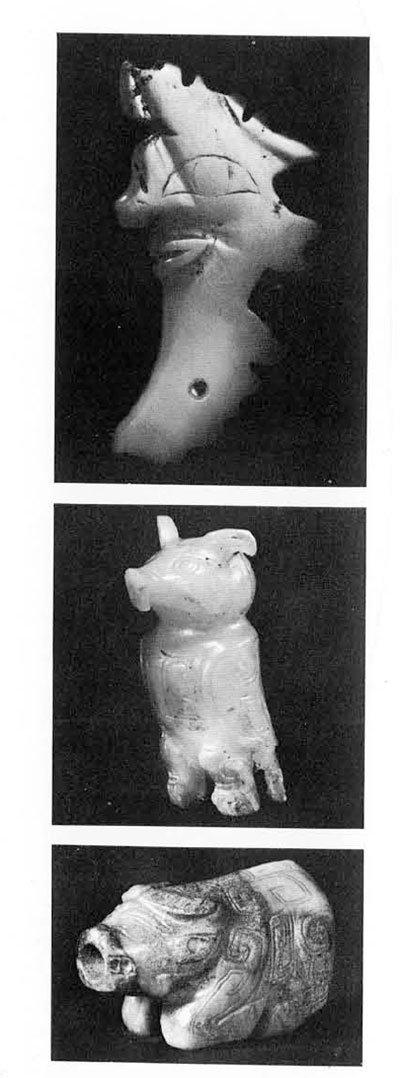
The nephrite of Turkestan and Siberia, and the jadeite of Burma are the only confirmed occurrences of jade minerals in Asia proper, except for a small body of jadeite reported from Japan. Jadeite magatama, the comma-shaped beads or amulets typical of prehistoric sites in Japan, are common in second and third century graves. Similar beads have been found in Korea in fourth to sixth century tombs. At the time of the exhibition Masterpieces of Korean Art, which toured the United States in 1957-58, some of these magatama were identified by x-ray diffraction as jadeite. The appearance of the Korean and Japanese jadeite is somewhat similar, a mixture of white and pale green in varying amounts. The finding of jadeite in Japan makes the jadeite beads in both Japan and Korea more easily explainable; the only other source of jadeite which might have been used, in Burma, was unknown until a much later date.
There are several occurrences of jade in the Pacific area. The Maoris in New Zealand used nephrite which they called punamu for ornaments and tools. Nephrite is found in situ and as boulders and pebbles on Mount cook and elsewhere on the South Island. Jade tools have been reported quite widely throughout Oceania, and on New Guinea unworked loose nephrite and also nephrite celts have been found. Jadeite occurs in situ in the Celebes, and chloromelanite has been located in New Guinea.
The only other area of the world where the art of working jade approached the quality it reached in China is Central America, where jade was used from 1500 B.C. to the time of the Spanish conquest, after which all knowledge of it disappeared. For many years no occurrence of jade in situ was known in Central America, but in 1955 jadeite was reported by William f. Foshag and Robert Leslie from Manzanal, Guatemala. This jade is light green and resembles the pale greenish jadeite used for Maya carved faces and Aztec ear plugs. The other two common colors of jadeite found among objects of Central America are an apple or emerald green, the Aztec chalchiutl, and a pale pearl gray used mostly for Olmec objects. The finding of jade in situ in Mesoamerica settled the question of American jade possibly having been imported from Asia, as had at one time been suggested. Even before this discovery it was known that the jadeite of Central America was usually a diopside-jadeite, while the material from Burma was the single mineral jadeite.
In South America, nephrite is known to occur at a single locality in Brazil, at Babytinga, near Amargoza. Rough nephrite is found elsewhere in Brazil, and nephrite celts are known among the aborigines of the Amazon River. Although jade objects are reported elsewhere in South America there are no other confirmed occurrences of the jade minerals.
The Eskimo of Alaska used jade implements, and native reports of the occurrence of jade on a mountain in the area of the Kobuk River were confirmed by the discovery, in 1883, of what was later called ‘Jade Mountain’ where nephrite occurs in situ. Boulders which are found in the stream beds below the mountain were probably the source of the material for the Eskimo. Alaskan jade is of various shades of green–yellow, olive, grayish, and blackish–and boulders of it show a brown weathered surface.
The Haida Indians of British Columbia also used jade tools; these have been found in several localities, including Queen Charlotte Island. Nephrite boulders are known in the lower reaches of the Fraser River and elsewhere in the area, but no jade has been located in situ to date. Jade from British Columbia sometimes resembles Alaskan jade, in varying shades of green, and can also be gray-white with light green spots. It is interesting to note that during the gold rush in the late nineteenth century tons of jade were shipped from there to China by Chinese laborers hired for the gold workings.
Although no artifacts have been reported from the western United States, occurrences of both nephrite and jadeite are known there. Both minerals occur in California. Nephrite pebbles and boulders are found on the coast near Monterey and elsewhere, and a locality in northern California supplies green, white, brown, and almost black nephrite. Jadeite outcrops in San Benito County, first discovered in 1936 and reported by the California Division of Mines in 1950 were the first reported occurrence of jadeite in the Western Hemisphere. Nephrite is also found in Wyoming where it was first discovered in the early 1930’s in the area of Lander in Fremont County, both in situ and as boulders. Wyoming jade is green, black, greenish brown, and pale gray. A large boulder weighing 2,495 pounds is now in the Chicago Natural History Museum.
The earliest known use of jade was by the Neolithic Lake Dwellers in Europe. Jadeite, nephrite and chloromelantine have all been reported as being used for their implements. The earliest report of jade in situ in Europe was of nephrite boulders in glacial deposits in Silesia, and there are now known occurrences of all three minerals in Italy, Germany, and Switzerland, as well as in Poland. Until the discovery of naturally occurring jade in Europe it was thought by some that it had been brought from Asia.
Isolated examples of both nephrite and jadeite have been reported from the ancient Near East, including Babylonian cylinder seals, but no occurrences of the minerals in the area are known, and the fact that the articles are of jade has not been confirmed. Some jade tools have been reported from ancient Egypt, but these also are unconfirmed. Recently, Sir Charles Hardinge has reported an occurrence of nephrite in Southern Rhodesia, the first on the African continent.
Because of the hardness of jade, the working of it into tools and ornamental objects required specialized techniques, especially in early cultures when extremely hard abrasives and power driven tools were not available. In some cases it is possible to obtain information about early jade working from analogies with methods used in the same area today, as in China. Sometimes the only information comes from the remains of tools and pieces of partly worked material such as those found in Guatemala.
The most complete discussion of the material and methods of modern and ancient Chinese jade carving is provided by Hansford in his book, Chinese Jade Carving. In the workshops of Peking in the 1930’s, jade was worked on foot-driven treadle lathes which could hold various tools of steel and wrought iron. Large p ieces were sawn first with a wire saw, abrasive being continually added as the sawing proceeded. The abrasives in use at that time were quartz sand (hardness 7), crushed garnet (7.5), corundum or emery (9), carborundum (9.5), and rarely diamond (10). Also used was a mixture of carborundum with loess or calcareous sand which was called pao yao. Carborundum, the artificial product silicon carbide, is a modern introduction which is responsible for the high gloss so characteristic of more recent pieces. This is not found in general on earlier jades, although the high polish on some Chinese objects of the third century B.C. and earlier is difficult to explain. Corundum, a naturally occurring aluminum oxide mineral, was probably introduced about the twelfth century, since by the fourteenth century large blocks of jade were being carved; this would have been almost impossible to do without a more efficient abrasive than garnet or quartz. Final polishing, at the time that Hansford observed the Peking jade workers, was done first with a lump of shellac mixed with fine carborundum, followed with a wheel of sandalwood, and then with leather buffering wheels; fragments of gourd were used to polish areas that were difficult to get at. The exact date of the introduction of iron tools is unknown, but it was of great significance in the history of jade carving. The first use of lathe-type rotary cutting and grinding tools was also an important step forward. There is strong evidence that they were introduced by the third century B.C., at the end of the Chou period, although the hand drills used for making perforations were of course in use before this. Hollow jade vessels could be made only with rotary tools, and it has been suggested that this is the reason that such vessels do not occur before the Chou Dynasty.
The jade working techniques of Mesoamerica must be inferred from evidence found at archaeological sites and have been well summarized by Foshag in his monograph, Mineralogical Studies on Guatemalan Jade. A jade worker’s tomb found at Kaminaljuyu in Guatemala has provided evidence of this nature. The raw material was first broken and trimmed if necessary to provide a piece of jade of the size needed. Sawing was probably done with a metal tool, such as copper, and an abrasive, but hardwood or bamboo saws could also have been used. The selected piece of jade was then shaped with a trimmed hard stone; there is evidence that peeking with a blunt stone tool by percussion was also used. The piece could also be rubbed down into shape on a hard stone; this grinding was used to provide slight modifications in shape and not for major changes. Flat stones with wide grooves on which this rubbing was done have been found. A narrow file-like tool was used as a rasp. Drilling was carried out with both solid drills of reed, bamboo, or bird bone. Polishing was done agains a hard tool, probably jade, in which case no abrasive was used, or against hardwood or the outer surface of bamboo, with an abrasive. The abrasives used by the Aztecs were possibly garnet sand, specular hematite, quartz or any hard stone sand, and crushed jade. The use of the latter is not known elsewhere, and it was found in the jade worker’s tomb mentioned above.
Methods of jade working used by the natives of Alaska and British Columbia can also be partially reconstructed from evidence of tools and partly worked material found on sites as reported by G.T. Emmons. In British Columbia, saws of sharp siliceous sandstone have been found, up to one foot in length, three to four inches wide, and a quarter to a half inch thick. There is evidence that boulders were sawn in parallel grooves two to three inches deep and a wedge was put in one groove and struck sharply, causing the piece to break. Flat thin boulders had a deep groove sawn on each face, and were then broken similarly with a wedge. Grindstones of sharp sandstone were used with water to give the final polishing. Similar methods were probably used in Alaska. Sawing was also possible with thin bone saws, with water and sand as abrasive. Pieces were ground into shape with other stones, and slabs could be smoothed by rubbing on a flat stone covered with sand. Drilling was possibly carried out with flint, or with a stick with water and sand.
F.R. Chapman in 1892 in the Transactions of the New Zealand Institute gives a description of jade working by the Maori. Pieces of fine sandstone were shaped to give a cutting edge and fastened into frames to provide a kind of saw; wood with wetted sand was also used for sawing. A piece was worked from both sides and then broken with a blow before the cuts met. Holes were drilled with a flint at the end of a split stick used as a bow-drill. Polishing was done with rubbers of fine sandstone or micaceous slate.
In Idzumo Province in Japan we find evidence on the working of beads, some of them jadeite, both in prehistoric times and at the present day. On one site, unfinished and broken beads, waste material, and grinding and polishing stones were found. The grindstones were of granite, with parallel grooves and large circular depressions, and the flat polishing stones were of various kinds of schist. In modern bead workshops in the same province a toothless iron saw with abrasive was used to cut the raw material, which was also chipped with an iron bar. Drilling was done with a steel awl, rotated while being struck with a hammer. Rough polishing was done on an iron board with carborundum, and a slate grindstone was used for finishing; parallel grooves were made by repeated grinding. It is not known if the ancient workers used the awl for drilling; there is some evidence they used a bow-drill.
From this brief summary of jade working techniques in various parts of the world it can be seen that there are several basic factors on which the development of the craft beyond that of simple tool making depends. One factor is the abrasives available. It is of interest to note that the most sophisticated carving developed in China and in Mesoamerica where abrasives harder than quartz were used, corundum in China, and crushed jade in Mesoamerica. Another factor is the use of metal tools, although the copper saws which were suggested as a possibility in Guatemala would have had to depend for their effectiveness on any abrasive used with them, as copper is extremely soft. In China, iron tools came into use at a date as yet undetermined; it would seem that most of the early jade carving was done without this aid. The third significant factor is the use of lathe-type rotary tools. The forerunner of these might have been the bow-drill which is known to have been used in New Zealand. Hand drills of some description were used in Mesoamerica, but no suggestion has been made of the use of lathe-type rotary drills there; in China they may possibly have been in use since the third century B.C.
As a material of art and archaeology jade is a unique material, of whose use, occurrence and history there is still much to be learned.
